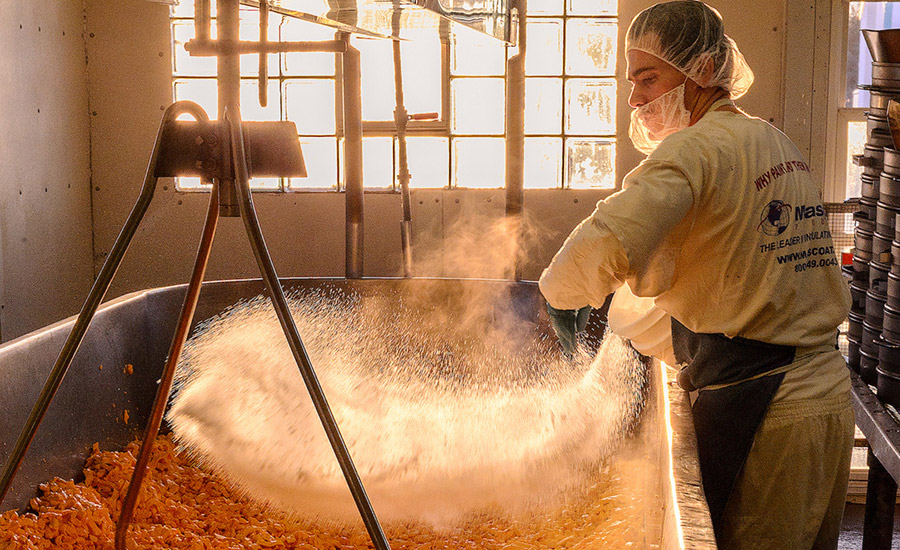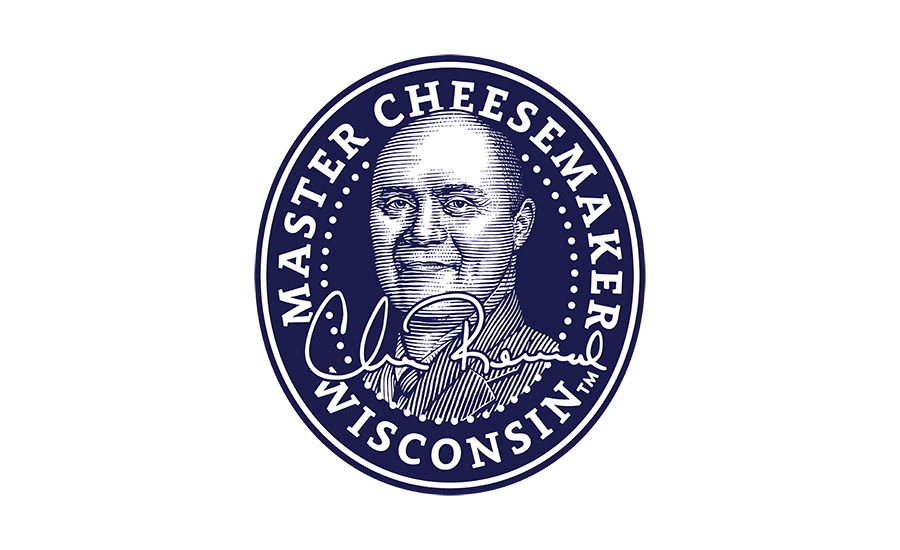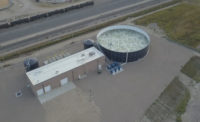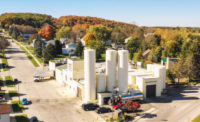Making cheese without any automation is a back-breaking, tiring job with a lot of stooping, stirring, manual washing of hoops and so on. When it comes to automation, “zero is not a hero,” for Master Cheesemaker Chris Renard and the team who handle production and packaging for Renard’s Cheese factory in Algoma, Wis.
There’s been zero automation for more than 60 years, and while that has not kept Renard’s from churning out 3 million pounds annually of its award-winning aged, hard and soft specialty cheese like its New World Cheddar, Terrific Trio and flavored cheeses like Farmer’s Pesto, Cherry Cheddar and 75 SKUs, the new $30 million plant due to be completed by the end of 2026 will be vital to Renard’s Cheese’s modernization and success.
“We do everything the old-fashioned way as far as recipes,” Chris Renard tells Dairy Foods during a recent visit. “But, you can only utilize your infrastructure for so long, and as the cheese industry gets smarter and makes new innovations, you need to reinvest and make it easier on your workforce in order to retain them, and you need to incorporate those efficiencies because you need to remain competitive.”
Since Renard’s Cheese was founded in 1961 by Chris’ grandfather, Howard Renard, and subsequently owned by his dad, Gary Renard, with Chris and his wife, Ann, taking over the third-generation family business in 2010, the intrepid cheese processor has seen eight expansions. Over the past 62 years, there’s also been retrofits of new equipment, several renovations, major rebranding, and building two cheese stores in two locations — one in Algoma, Wis., which shut down in October 2022, and is expected to reopen after the manufacturing expansion is complete, and the current 10,000-square foot retail shop featuring a Chocolate Shoppe Ice Cream and a Melt Bistro at 2189 County Road visible from Highway 57 in Door County’s Sturgeon Bay.
Located about 11 miles from Sturgeon Bay, the Algoma-based cheese plant stands on hallowed grounds, as there’s been a cheese factory on that corner since the 1880s, Ann says. Even when it burnt down between 1910 and 1920, it was rebuilt immediately.
“It’s about 3,000 square feet with the make area. If you add the rest of it, it’s about 4,000. Since my grandfather bought it in 1961, there’s been one addition to the manufacturing plant and two additions to Cold Storage, and they built the Cheese Shop in 1976,” Chris says. “Other than that, we’ve just remodeled. We brought new equipment in, we’ve revamped old vats, our string cheese machine was brought in, we just redid the cut and wrap area, and we’re in the process of adding onto the wastewater system.”
Due to be completed in 2026, the $30 million plant expansion and renovation will enable Renard’s to quadruple its production — from handcrafting 3 million pounds of cheese to making 12 million pounds of small-batch artisan cheese annually by adding more cheesemakers and a second shift.
“…We’ve turned down 4 to 6 million pounds of production a year in the past. We’ll be able to accommodate that and we’ll be able to pick up the farms that are on our waiting list. We have 17 small family farms,” Chris says. “We’ll be more efficient and be able to maintain our workforce for longer periods of time. They have all the knowledge, it’s just the wear and tear on their bodies.”
Currently, there’s a small but mighty 20 team members running the plant and warehouse, with an additional seven handling the packaging side of operations.
“We do everything the old-fashioned way as far as recipes. But, you can only utilize your infrastructure for so long, and as the cheese industry gets smarter and makes new innovations, you need to reinvest and make it easier on your workforce in order to retain them, and you need to incorporate those efficiencies because you need to remain competitive.”
— Chris Renard, Master Cheesemaker at Renard’s Cheese
A laborious task
Making the company’s award-winning cheese curds, for example, isn’t easy the way the plant is currently set up. Chris explains: “We are bending over a vat, so it’s hard work on your back, and you are reaching down to almost your ankles. They take 25 pounds of cheese, turn them, stack them, and then run them through a curd mill. To get the curds out of the machine you take a pail that weighs about 35 pounds, but you’re pulling that away from your body, so you can add about 10 times the weight as that pail is away from you. We weigh that, dump it, and put it into a form. It’s all physical labor all the way through. We manually take the cheese out of the form at the end of the day, bring them in the cooler, and wax them by hand.”
Co-owner and Operations Manager Ann notes that Renard’s fresh squeaky curds and breaded curds are two of the company’s top sellers. “Our squeaky curds are more of a snack. You can eat them with your fingers or on crackers. Our cheese curds are made fresh daily. Anything you buy from our store is made fresh daily.”
In volume, 1.5 million pounds of squeaky and breaded cheese curds are processed annually and “we definitely have the opportunity to sell more breaded cheese curds right now,” Ann relays. “It’s just that we don’t have the capacity because they are all handmade. We have to store 50,000 pounds in Green Bay, Wis., about 40 miles from here, because we don't have enough freezer space to accommodate. So, that’s part of our phase-two expansion.”

Enhancing and expanding cheese curd operations
To date, Renard’s Cheese reports it sells 50,000 pounds of cheese curds in its store; 500,000 pounds to food service, 300,000 to 400,000 pounds are sold wholesale; and 450,000 hand-breaded curds are sold to about 90% of the restaurants in Door County.
“The new plant is just going to be so much more efficient,” Chris says, further pointing out the many steps involved in making cheese curds.
“For example, breaded curds; we hand bin up all the curds, truck them over to here [Sturgeon Bay], where staff take them back out, break them up, run them through the breading process, freeze them in the freezer, and next day, they'll handbag them all,” he states. “Right now for a four-person crew, we do about 20 bins in an eight-hour shift, as far as binning. But that doesn't take into account loading it up and all the other labor that goes into it.
“They come over in 45-pound bins, so when you’re talking about handbreading 500,000 pounds of cheese curds a year — that’s 10,000 bins coming from our cheese plant,” he continues. “They’re making a 15-minute drive one way three to four times a day. We got a bigger truck to do that, originally we just had a small cargo van and they would sometimes make 15 trips in a day. All our warehouse space is [in Algoma], and we have very limited warehouse space here [at our shop]. Or, they truck it to Green Bay.”
Yet, once the newly reconfigured plant is up and running in mid- to late 2026, worker ergonomics and the production of Renard’s Cheddar, Colby, Monterrey Jack, Farmer’s, Muenster, Brick, Colby Jack, and its fresh and breaded cheese curds, string cheese and its aged and specialty cheese will grow four-fold — to 12 million pounds and annual dollar sales of $50 million, Chris estimates.
“But instead of having to bend down to get the cheese, we’ll be pumping it onto matting tables,” he explains. “Our workers will be able to work at waist level. The slabs will be about the same weight, but we’re adding a more body friendly way of turning the cheese and handling it. We’ll still be milling the curds to get the same great cheese curds we make.
“We’ll have a more automated way of filling the hoops where someone just has to take the full hoop and replace it with an empty one,” he continues. “The stainless-steel hoops, the forms the cheese is going into, creates the wheel of cheese.”
Renard’s manufactures its cheese in four round wheel hoops of 3-, 12-, 22- and 38-pounds, and a 40-pound block. Right now, the hoops are hand-washed, but after the renovation they’ll be sent to a tunnel to be washed.
When asked what equipment is most vital to Renard’s cheesemaking operations, Chris responds, “the vats, they’re holding all the milk and all the work is being done in them. If the vats aren’t cooking and agitating correctly, it’s going to affect the cheese flavor.”
Production-wise, the new cheese plant will add two more vats, from four vats to six vats, which will eliminate the need to wait until the first vat is empty to go back in. “Those additional vats will help streamline our process,” Chris states. “We’ll be able to go one through six and come back to one. We also have our string cheese line and in the new plant, our cheese curds will go right to a breading line.”
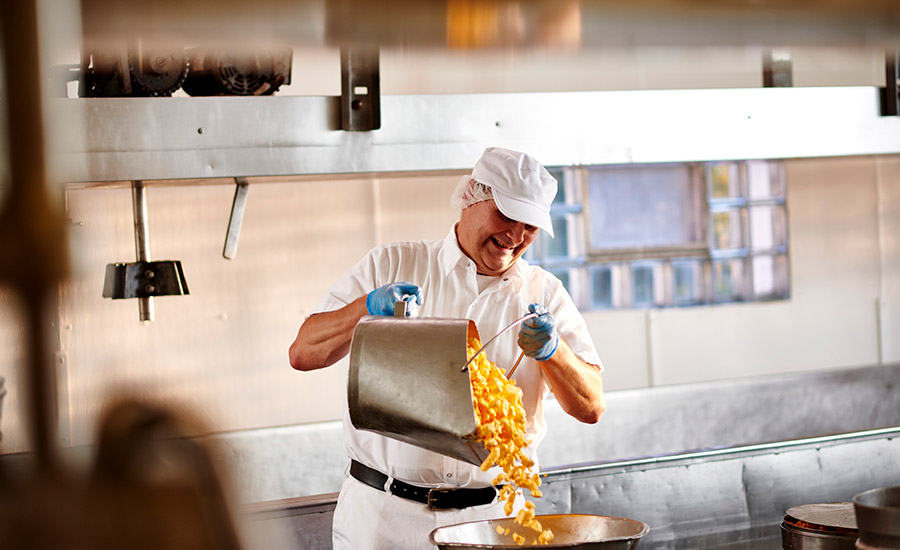
Aging cheese and figuring out the flavor
In phase one of construction, a new trial vat was added to enhance research and development. “We started making the New World in 2020. It took a little trial and error. We had four attempts on that one, to get it to where we liked the taste. When making a cheese, the struggle is you can make it, but trying it the next day, you have no idea what the flavor is,” Chris states, noting that a young cheddar and a young Colby will taste the same for the first seven to 10 days before the cultures and the milk start affecting the flavor.
Patience, logging everything and taking excellent notes also is crucial to making aged cheese. “For our New World Cheddar, we aged it for a minimum of eight months. We made it and we waited a long time before we tried it,” Chris highlights. “Another example is our Legacy Cheddar, which is Gouda and cheddar blend. The first time I tried it after two months, I thought I had made a really bad batch of cheese, it had a really sour taste to it. At four months, the flavor started coming around, and at six months we got what we were going for. It took that long to figure it out.”
Resuming tours and an educational focus
Ann and Chris note that the plant expansion also is going to enable Renard’s Cheese to showcase its cheesemaking operations with a revised tour program. Tours began in 2014 but stopped in 2020 when COVID-19 hit and haven’t resumed because of construction.
“We wanted to educate consumers [about] the entire cheesemaking process, everything from the farm to the milk running into the vats, the milling of the cheese to the end product and how there is no waste — it’s very sustainable,” Ann states. “How it takes 10 pounds of milk to make 1 pound of cheese, explaining our styles of cheese, and how we handcraft our artisan small batch cheese.”
When guided tours resume in 2026, there’s plans to incorporate a farm as part of the educational process.
“So people can really see cheese as being a farm-to-table product,” Ann explains. “For sanitation purposes, they’re able to observe our manufacturing facility through windows. We want to be have tours for youth and schools as well, and perhaps inspire others to join our family business.”
Chris concludes: “Renard’s Cheese has been a passion project for 62 years, and I couldn’t be more proud of all that Ann and I are our hard-working team have built and accomplished — from crafting some amazing aged cheese and small-batch specialty cheese that reflect our small-town Door County roots and amazing journey. But we firmly believe, like Frank Sinatra sang, ‘The best is yet to come and won’t it be grand.’”
> More information on Renard's plant operation
About Renard’s Cheese Operations
Founded: 1961 by Howard Renard, with Gary Renard taking over the family business in 1966.
Headquarters: 10,000-square-foot store, ice cream shop and melt bistro at 2189 County Road, Sturgeon Bay, Wis.
- 4,000-square-foot cheese plant at 248 County in Algoma, Wis.
1975: First Cheese Shop opens.
1996: Chris Renard returns to Door County, Wis., and earns cheesemaking license.
2010: Husband-and-wife duo Chris and Ann Renard become third-generation owners.
2012: Second Cheese Shop, Ice Cream Shop and Melt Bistro opens.
2014: Chris earns title of Master Cheesemaker.
2023: Manufactures 75 SKUs of cheese, with aged cheese being 20% of portfolio, including New World Cheddar, Hoop Cheddar, and Terrific Trio. The longest aged cheese is 15 years.
- 80% of portfolio consists of higher moisture cheese and flavored cheese such as Monterrey Jack, Farmer’s Cheese, Cherry Cheddar, and new Farmers with Guacamole.
- 1.5 million pounds of top-selling squeaky and breaded cheese curds produced.
Current cheese production: 3 million pounds with 350,000 gallons of milk from 16 family farms.
2023 sales: $20 million.
Employees: 75
Distribution and Exports: 45 distributors with Renard’s Cheese available in the U.S. and Middle East (Dubai and Saudi Arabia).
2026: New $30 million, 50,000-square-foot cheese plant in Algoma, Wis., operational.
- Going from zero automation to 75%.
- Adding two more vats, six total.
- Hoops will be tunnel washed.
- Dedicated string cheese line, dedicated cheese curd breading line.
- Producing 12 million pounds of cheese, second shift added.
2026 sales: $50 million (projected).
2026: Expanded tour program reopens.

